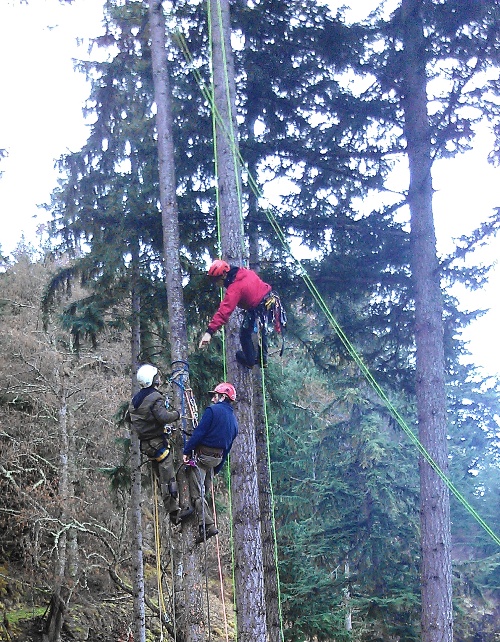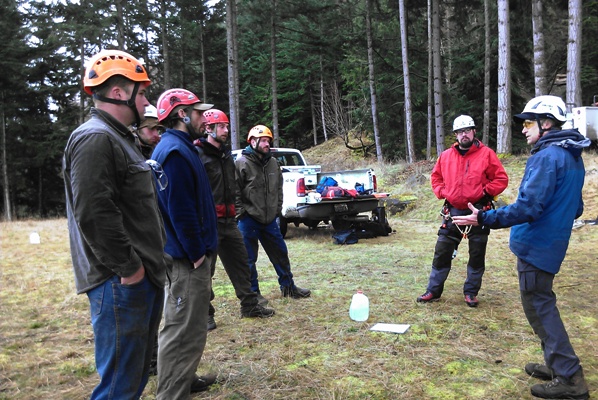
In an aerial rescue exercise, Keegan Cookston, on the left, portrays an injured worker; he is aided by Phoenix Welty in the blue jacket. Jeff Wakefield, in the red jacket, monitors the situation. Cookston and Welty are employees of Shaner Excavation and Tree Services.
By Margie Doyle
Bathan Shaner is an island-born tradesman who is intent on growing his business in a safe way. In order to provide safety for his employees and his customers of Shaner Excavation and Tree Service, he has spear-headed efforts to coordinate safety and rescue practices among area colleagues.
Most recently, he arranged for instructors David Stice, James Luce, and Jeff Wakefield from Ascension Group NW to come from Bellingham and instruct island “climbers.” Last Saturday, March 16, company employees from Baisch Tree Service, Island Skyline Tree Care, Rainshadow Consulting, joined Shaner Excavation & Tree Service staff and spent the day going through drills and discussing scenarios that are part of their business scenarios.
Several drills had one climber as an injured “dummy;” another climber was the “rescuer,” and at all times, one of the Ascension crew monitored the operation. Those on the ground discussed the techniques used, including checking in constantly with the injured party and coordinating emergency care with other rescue agencies.
They brought out that Emergency Medical Technicians (EMTs) can only travel to the base of a tree, which may be in a remote and/or heavily-forested area. “The only way down is for another climber to get them down,” said one of the professional tree-huggers.
The goal was to bring county tree climbers together, and practice one system of climbing rescue, Shaner said. “We do the exercise so we’ll know what to do if a certain scenario arose.”

The Ascension NW instructors talk to the island climbers, detailing the complexities of a one-on-one rescue situation
Those practices include injury assessment, monitoring vital signs and triage of response. They noted that a professional tree climber is required to have the proper level of training to administer oxygen, take care of cervical and spine injuries and “packaging transport” — at a minimum.
Many are qualified for rescue as Wilderness First Responders.
The group chatted and snacked around a small campfire on the blustery day at Raccoon Point, recalling past incidents. The described one absent climber, on the mainland, as “a real old-school hot dog.”
One climber related falling out of a tree, and breaking his foot, nose and teeth. “It destroyed my pride and my ground guy’s nerve,” he said, yet now he’s back in the trees; his son wants to be a climber too.
They say their work is “a growing market,” and that business keeps them busy. They casually note that they are less competitive and “more civil” than their urban counterparts.
Shaner has been in the excavation and tree service business for over 15 years and has owned his own business for five years. His motto is “Business Built by Referrals — ask someone about me.” Shaner Excavation and Tree Service provides erosion control, boom truck service and septic inspection and installation as well as tree services.
In between exercises, the men talked about trips to remote areas and islands, involving kayaking, forests and wildflowers, always circling back to the tree experiences that brought them.
“I guess when trees get in your blood they stay there,” said one of them, as the others smiled and nodded their heads in agreement.
**If you are reading theOrcasonian for free, thank your fellow islanders. If you would like to support theOrcasonian CLICK HERE to set your modestly-priced, voluntary subscription. Otherwise, no worries; we’re happy to share with you.**








Practicing Aerial rescues is a necessity. Fair play to all you guys, wherever the hell you’s are. Sounds remote i bet some tricky scenarios do arise.
Proud to see you guys taking your work serious. I know it is very taxing on both mind and body. You are very smart to plan ahead for contingencies which might occur instead of waiting for them to happen and not know what to do. Congratulations and take care.